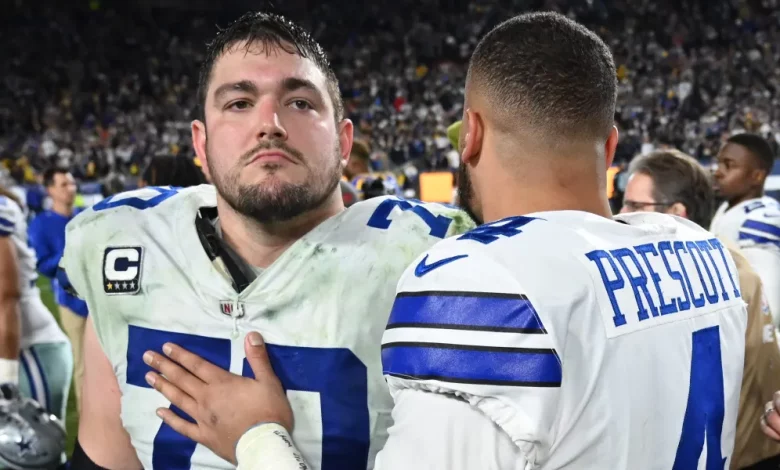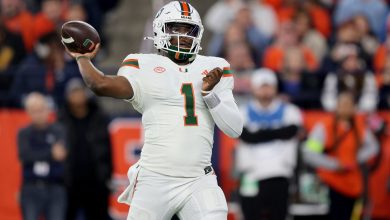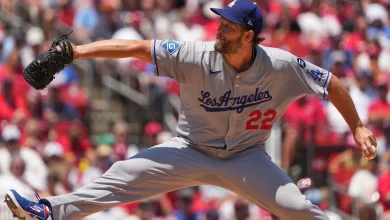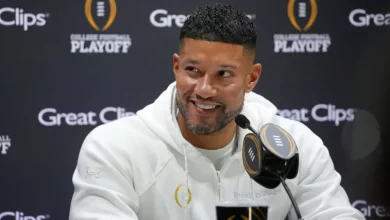What impact does Zack Martin’s retirement have on the salary cap for the Dallas Cowboys?

Zack Martin, an iconic player for the Dallas Cowboys, has been a cornerstone of the team’s offensive line since being drafted in 2014. His dominance on the field and his leadership in the locker room have made him one of the most important and respected players in the NFL. However, as with all NFL players, Father Time is always lurking, and eventually, the day will come when Martin hangs up his cleats. This leads to an important question for the Dallas Cowboys: What will be the financial impact of Zack Martin’s retirement on the team’s salary cap?
In this article, we’ll explore the various facets of Zack Martin’s contract, the potential cap implications of his retirement, and the broader effect it could have on the Dallas Cowboys’ roster and future salary cap planning.
Zack Martin’s Contract Overview
To fully understand the financial ramifications of Zack Martin’s eventual retirement, it’s important to first break down the details of his current contract. Zack Martin is signed through the 2024 season. He was given a six-year contract extension worth $84 million in 2018, which made him the highest-paid guard in NFL history at the time. The deal included a $20 million signing bonus, base salaries, and several other clauses that structured the total amount over several years.
As of now, Martin’s contract still has significant guarantees, including his 2023 and 2024 salaries. Given the length of his deal, there are several important elements of his contract that will determine how the Cowboys will handle his retirement and the impact it will have on their salary cap:
- Base Salary: Martin’s base salary for 2023 is $8.5 million, with a similar amount in 2024, which will factor into the Cowboys’ cap for the years ahead.
- Cap Hit: Martin’s cap hit for the 2023 and 2024 seasons will be larger than his base salary due to his signing bonus and other contract details. In 2023, his cap hit is projected to be around $14 million, and it will likely be similar in 2024.
- Dead Money: If Martin were to retire or be cut, the team would still carry “dead money” from the prorated signing bonus and other guarantees that remain on the contract. This dead money would count against the Cowboys’ salary cap for the remaining years on Martin’s deal.
- Performance-Based Incentives and Option Bonuses: While not as significant as Martin’s base salary and signing bonus, his contract also includes performance-based incentives and option bonuses that could impact the cap depending on the details outlined in his agreement.
Understanding these key components of his contract will allow us to calculate the potential impact his retirement could have on the Cowboys’ salary cap. But first, we need to look at what happens when a player like Martin retires early or is released before his contract expires.
What Happens When Zack Martin Retires?
When an NFL player retires, the financial ramifications are generally tied to the structure of the contract they signed. In Martin’s case, there are multiple factors that could come into play if he decides to retire before the end of his contract:
- Prorated Signing Bonus: Signing bonuses are prorated over the life of the contract. This means that Martin’s $20 million signing bonus was spread out over the six years of his contract, which equates to $3.33 million per year. If Martin retires, the Cowboys will still owe the remainder of the prorated signing bonus for the years he didn’t play, which will accelerate as “dead money” onto the salary cap. This dead money would be factored in for the seasons that remain on his contract.
- Remaining Salary: Martin’s remaining base salary, which would include his $8.5 million base salary for 2023 and likely a similar amount in 2024, would also be accelerated against the Cowboys’ cap. This would mean that the team might have to take a hit for any unpaid portion of Martin’s salary for the remaining years of his contract.
- Accelerated Bonuses and Guarantees: Any other bonuses or guarantees attached to Martin’s contract could also accelerate into the current cap year. This would include option bonuses, roster bonuses, and other performance-based incentives. These would count as “dead money” and could potentially push the Cowboys over the cap if not properly accounted for.
Projected Salary Cap Hit After Retirement
If Zack Martin were to retire after the 2024 season, the Cowboys could face the following financial consequences based on the structure of his contract:
- Dead Money: As mentioned earlier, the signing bonus is prorated over the life of the contract. If Martin were to retire before the final year of his contract, the Cowboys would need to account for the remaining prorated signing bonus as dead money. Since Martin’s signing bonus was worth $20 million, and it was spread out over six years, the Cowboys would face $3.33 million in dead money for each year of the remaining contract. If he retired after 2024, this would be prorated for the last two years, which means the Cowboys would take a cap hit of around $6.66 million in total dead money.
- Base Salary Acceleration: Martin’s 2023 and 2024 base salaries would likely remain the same, and any unearned portion of those salaries would likely accelerate onto the cap. This could add anywhere from $8 to $10 million to the Cowboys’ cap hit, depending on how the retirement is structured.
- Total Cap Impact: In total, the Cowboys could face a cap hit of between $14 million and $16 million if Martin retires before the 2024 season. This hit would come in the form of dead money from his signing bonus, base salary acceleration, and any other unaccounted-for guarantees or bonuses.
Long-Term Effects on the Cowboys’ Salary Cap
A retirement like Martin’s could have ripple effects that extend beyond just the immediate cap hit. Here are some of the long-term consequences that the Cowboys would have to consider:
- Cap Space Flexibility: The Dallas Cowboys have typically been aggressive in maintaining salary cap flexibility. However, a hit of $14 million or more in dead money would significantly impact the team’s ability to sign new free agents or extend current players. This would limit their room to make other roster moves, forcing them to either restructure existing contracts or let go of veteran players in other areas of need.
- Opportunities for Younger Players: While the immediate cap impact would hurt the Cowboys’ ability to build through free agency, it could also open the door for younger players on the roster to step into bigger roles. This could be beneficial in the long term if the Cowboys choose to develop their own talent rather than paying top dollar for free agents.
- Draft Planning: The retirement of Zack Martin would likely prompt the Cowboys to shift their focus toward drafting offensive line talent in the coming years. This is an opportunity for the team to replenish its roster with younger talent, though the cap hit from Martin’s retirement may make it more challenging to immediately bring in veterans who could help offset the loss of such an important player.
- Revising the Roster Structure: With a large dead money hit on the books, the Cowboys may be forced to reconsider their overall roster structure. They might need to make difficult decisions, such as cutting or trading other players with high cap numbers, to maintain cap compliance and create the flexibility they need.
- Impact on Dak Prescott’s Contract: As the Cowboys continue to build around quarterback Dak Prescott, the team will have to carefully manage his contract and its cap implications. While Prescott’s deal was restructured in 2023, the potential loss of a top offensive lineman like Zack Martin could force the Cowboys to reassess how they structure Prescott’s deal moving forward.
The Future After Zack Martin’s Retirement
Zack Martin’s eventual retirement will undoubtedly leave a massive hole on the Cowboys’ roster, both on the field and in the salary cap. While his leadership and playmaking ability will be difficult to replace, the financial impact of his retirement could prove challenging in the short term. The Cowboys will need to navigate a significant dead money hit, which could limit their flexibility and ability to make moves in free agency or re-sign key players.
However, if the Cowboys have planned effectively for this eventuality, they should be able to manage the cap impact and continue to develop young talent. The key will be to strike a balance between maintaining financial flexibility and ensuring that the offensive line remains a position of strength moving forward.
Zack Martin’s retirement may mark the end of an era for the Cowboys, but how the team responds to the challenge will ultimately shape its future. The Cowboys will need to find a way to replace his on-field production while navigating the financial consequences of his retirement. In doing so, they’ll look to continue their pursuit of another championship, even without one of the best offensive linemen the league has ever seen.









